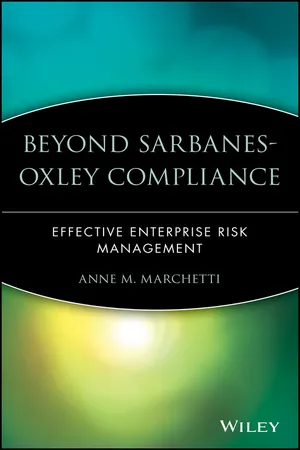
- English
- ePUB (mobile friendly)
- Available on iOS & Android
About this book
Designed to lead financial managers from initial compliance with the Sarbanes-Oxley Act, through ongoing maintenance and monitoring, Beyond Sarbanes-Oxley Compliance helps readers seize this opportunity to revitalize their business practice, drive greater performance, and transform their finance organization into a key contributor to the business. Focusing on the present and future financial road ahead, Beyond Sarbanes-Oxley Compliance explores how to implement enterprise risk management processes that comply with Sarbanes-Oxley 302/404/409 requirements, ways to build on initial compliance activities that will improve financial management processes and profitability, compliance and quarterly close checklists, timelines, and table summaries to help readers achieve their goals, and much more.
Frequently asked questions
- Essential is ideal for learners and professionals who enjoy exploring a wide range of subjects. Access the Essential Library with 800,000+ trusted titles and best-sellers across business, personal growth, and the humanities. Includes unlimited reading time and Standard Read Aloud voice.
- Complete: Perfect for advanced learners and researchers needing full, unrestricted access. Unlock 1.4M+ books across hundreds of subjects, including academic and specialized titles. The Complete Plan also includes advanced features like Premium Read Aloud and Research Assistant.
Please note we cannot support devices running on iOS 13 and Android 7 or earlier. Learn more about using the app.
Information
PART ONE
INITIAL COMPLIANCE
1
SARBANES-OXLEY ACT OVERVIEW
OVERVIEW OF THE ACT
Title Summaries
Title 1. Public Company Accounting Oversight Board (PCAOB or “Board”)
Title 2. Auditor Independence
Title 3. Corporate Responsibility
- Existence of audit committee oversight of registered public accounting firm
- Board of directors/audit committee independence
- Procedures for receiving complaints concerning accounting or auditing matters and anonymous employee concerns relating to questionable accounting or auditing matters established by the audit committee
- Audit committee authority to engage independent counsel and other advisors
- Provision of appropriate funding, as determined by the audit committee, for payment to the registered public accounting firm and to advisors hired by the audit committee
Title 4. Enhanced Financial Disclosures
Title 5. Analyst Conflicts of Interest
Title 6. Commission Resources and Authority
Title 7. Studies and Reports
Title 8. Corporate and Criminal Fraud Accountability
Title 9. White-Collar Crime Penalty Enhancements
Title 10. Corporate Tax Returns
Table of contents
- Cover
- Table of Contents
- Title
- Copyright
- Dedication
- ACKNOWLEDGMENTS
- PREFACE
- PART ONE: INITIAL COMPLIANCE
- PART TWO: ONGOING MAINTENANCE AND MONITORING
- PART THREE: BEYOND COMPLIANCE
- APPENDIX A: SARBANES-OXLEY SECTION
- APPENDIX B: SARBANES-OXLEY SECTION
- APPENDIX C: SARBANES-OXLEY SECTION
- APPENDIX D: EVALUATION QUESTIONS TO UNDERSTAND THE CURRENT STATE OF CONTROL PROCESSES
- APPENDIX E: INTERNAL CONTROL OVER FINANCIAL REPORTING
- APPENDIX F: EVALUATING CONTROL DEFICIENCIES
- APPENDIX G: SAMPLE DOCUMENTATION
- APPENDIX H: AS2 CONTROL TESTING PROVISIONS
- APPENDIX I: RESPONSIBILITIES OF INTERNAL AUDITING
- APPENDIX J: ACTUAL INTERNAL CONTROL DISCLOSURES
- INDEX
- END USER LICENSE AGREEMENT